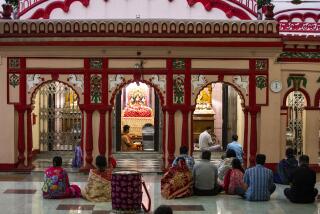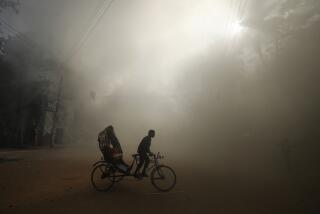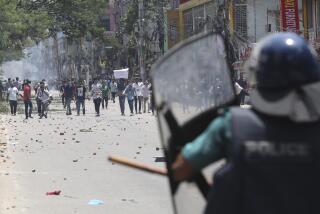Deadly Religious Riots Spread to Indiaâs Capital : Asia: Rampaging youths torch homes and shops. Residents flee violence stemming from razing of mosque.
NEW DELHI â In a new escalation of Indiaâs turmoil, deadly religious riots spread to part of the nationâs capital Friday in an orgy of arson, bombings, stabbings and shootings.
The Seelampur district of northeast Delhi, a crowded middle-class community of Hindus and Muslims, was a war zone for most of the night and all day Friday as rampaging crowds of rock-throwing youths torched scores of homes and shops, burned at least one man and two children alive, hacked others with swords and fought police in pitched street battles.
Residents said most of the victims were Muslims.
Riot police repeatedly fired rifles and pistols, pulled men from their homes and raced through rubble-strewn streets in jeeps and trucks past terrified families fleeing with only bedrolls and bags. Roaming gangs of Hindu youths still controlled the smoke- and tear-gas-filled alleys at nightfall as fires--and fear--raged out of control.
âThe fires are everywhere,â said N. K. Batura, one of dozens of firefighters battling blazes that roared on almost every block around a burning timber market. âAll over. Canât count them. We put one out, they light another!â
It was a fair description of Indiaâs continuing crisis Friday. Although the violence overall appears to have abated, the Delhi riots suggest that the nationâs convulsions can still erupt anywhere, five days after India exploded in fury triggered by the demolition by militant Hindu zealots of a disputed Muslim mosque in Ayodhya.
So far, about 1,100 people have died in the riots, and the vast nation has divided on class, caste and religious lines over the challenge of maintaining a secular state in a country where Hindus far outnumber Muslims.
Scattered Hindu-Muslim clashes were reported again Friday, especially in Gujarat and Karnataka states, and thousands of army and paramilitary troops maintained a tense control of Indiaâs two largest cities, Bombay and Calcutta.
Even as the riots raged, Prime Minister P. V. Narasimha Rao insisted that âthe worst part is behind us.â At a 40-minute news conference under a tent at his heavily guarded residence in New Delhi, Rao said, âItâs only a matter of days before we come back to normal.â
Although witnesses, hospital officials and local reporters in several parts of the country say the majority of those killed this week were Muslims shot by mostly Hindu police, Rao insisted that the police had not overreacted.
âPolice have to be firm when needed,â said Rao, a frail, bald man who sat hunched over with a white blanket on his shoulders as he spoke. âI have not come across any case of excessive use of force, or firing when it was not warranted.â
He added that he does ânot think the responsibility lies on meâ for either the widely predicted Hindu assault on the Ayodhya mosque or the murderous rampage of religious riots and reprisals that almost inevitably followed.
Indiaâs Muslim leaders clearly disagree. Syed Abdullah Bukhari, imam of Jama Masjid, the countryâs largest mosque, told families who lined roofs in Delhiâs Old City after Sabbath prayers that a fire was âstill ragingâ and the government was âputting out this fire with bullets and guns.â
âWere you waiting for this fire so you could shoot us?â he asked, referring to Rao. Because of a curfew, only about 150 men prayed on mats in the mosqueâs giant courtyard, usually packed with 20,000 Muslims on Fridays.
But the usually fiery Muslim leader urged restraint and said he had postponed plans to lead a protest march in defiance of the police-enforced curfew in the Walled City Muslim quarter of Old Delhi. There was little apparent restraint in northeast Delhi, however.
What set the riot off is unclear. Hindus said it began after Muslims in the Jaffarabad neighborhood stormed a police post, stabbed a constable and stole his submachine gun and radio late Thursday night. Muslims said it was Hindus who caused the trouble, angrily throwing rocks and firebombs after the government banned five extremist organizations--three Hindu, two Muslim--for inciting communal hatred and violence.
Others said the riot needed no reason, simply that shooting, arson and confusion broke out almost immediately. At least six people were killed and 35 injured by late Friday, police said.
Both sides suffered. A small mosque was burned, and holy books still smoldered inside. Several Hindu temples were broken and littered with rocks. Muslims said police had ransacked their homes and fired at them. Hindus said Muslims had thrown homemade bombs and gasoline-soaked rags.
A stream of Hindu men, women and children hurried through the rubble-filled streets, over broken bricks and glass, past burning buildings. Many carried bedrolls or other belongings. âWe are like refugees in our own country,â said Sublash Park, 22, a student.
Hindus insisted that Seelampurâs outnumbered Muslims had started the fighting by shooting and throwing firebombs. âThey are firing from the mosque and shouting, âWe will kill all the Hindus!â â said Shiv Kala, 21.
If so, Hindus clearly were getting revenge Friday afternoon. Down one muddy alley, past a burning cart and motorcycle, a small, thin Muslim woman stood wailing and whimpering. Her two children were dead, she said.
âMy children! My children!â she wept, pointing at an apartment burning atop a blazing brick building. Firefighters slowly handed up buckets of water, with little effect on the fierce flames and billowing smoke. âThey try to kill us all,â said her husband, Namal Hak, as tears poured down his face.
Nearby, a man was burned to death. His charred corpse still smoldered at a doorway, his legs asunder and torso twisted.
âThere is a single Mohammedan house here,â explained Bharat Joshi, 24, a student. âAnd he shoots from his roof. So we shoot at him.â Police said they had rushed 19 companies of paramilitary troops back to the capital from Ayodhya to help quell the unrest.
More to Read
Sign up for Essential California
The most important California stories and recommendations in your inbox every morning.
You may occasionally receive promotional content from the Los Angeles Times.











